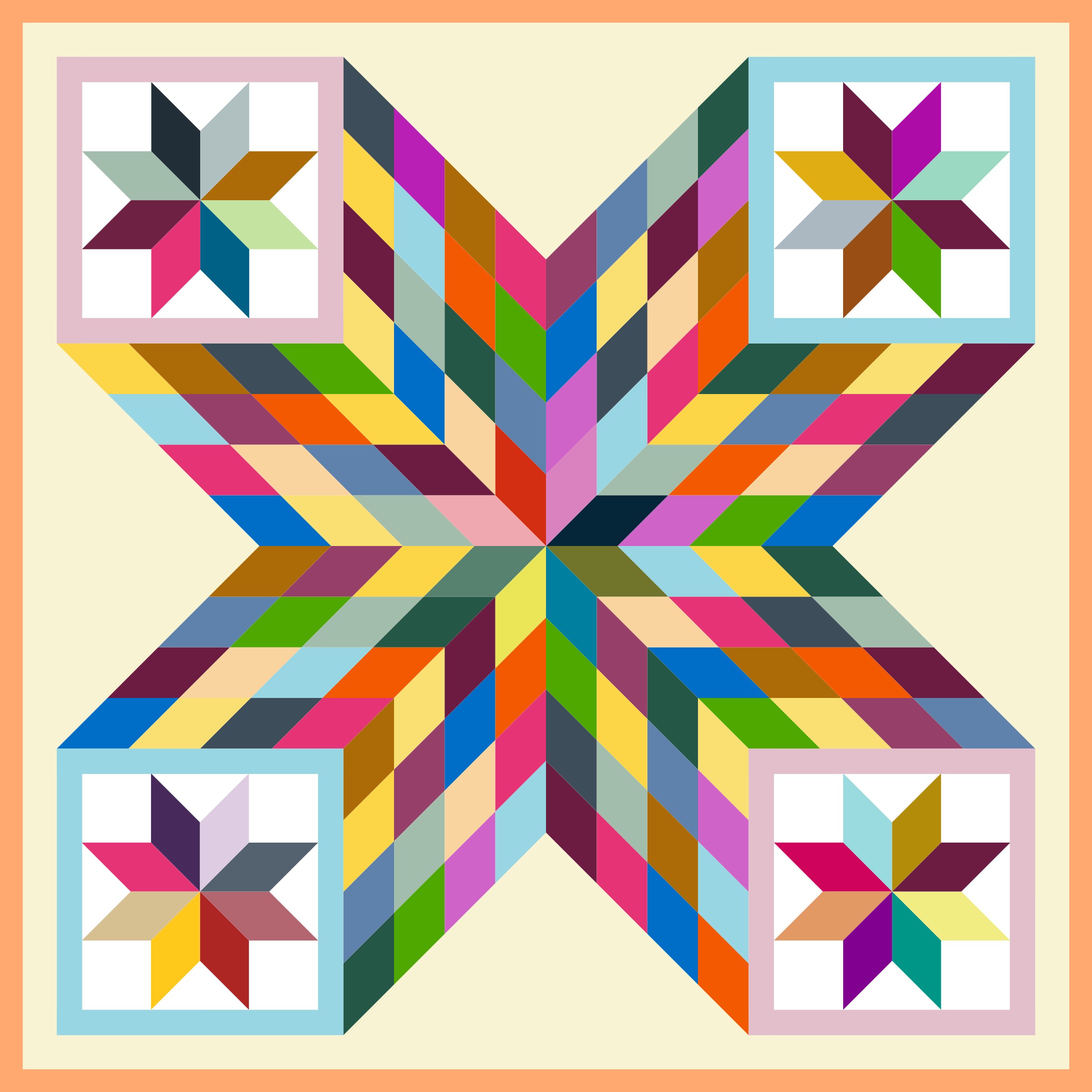Starburst
Block Number: H 2“Starburst”
As you travel west on Interstate 40 past Marion take exit 75, Parker Padgett Road, and turn right onto Greenlee Road. Continue for a couple of miles and you will round a curve. Right in front of you, just to the side of the road, sits a red-roofed barn displaying an 8-foot by 8-foot Rural Heritage quilt block called “Starburst”.
Mike Lucas of the McDowell Quilt Trail, with the assistance of Jack Raker, installed the block, while the hosts, Allan and Sharon Baker, along with other family members and Quilt Trail volunteers looked on. The Baker’s horses, Buddy and Moose, kept the onlookers entertained until the project was finished, after which Jill Lucas presented the Certificate of Authenticity to Sharon and Allan.
“Starburst” is the second Rural Heritage Quilt Trail block to be installed. Jan Zimmerman, who is a paint volunteer, assisted Mike with the painting of this optical illusion block. The eight-pointed star is made up of multiple diamonds in different colors that transition into four three-dimensional cubes as they burst forth from the star. As you gaze into the center of the four cubes from whence they originate, you then see the eight-point star. The foreground or face of each cube has a miniature eight-point star formed by a boarder of blue and pink.
This very unique star pattern is taken from a quilt in Sharon Baker’s quilt collection that was pieced by grand-mother, Eunice Parker. Sharon’s mother, Edna Parker Johnson, was on hand for the installation, and reported that the quilt top was pieced using feed sack fabric that was then commonly used.
Edna says of her mother, “Nothing was wasted.”
Taking a closer look at the quilt, some of the diamond shapes that made up the star pattern consisted of two or more different pieces of fabric, which attests to the habit of this generation’s putting everything to use and not wasting anything.
Sharon Baker’s mother grew up on a farm in Fairview community of McDowell County with her parents, Marion and Eunice Parker, were the family raised the requisite farm animals. The animal feed came in printed cotton feed sacks, which was a bonus for the wives and mothers of the 1930s and into the 1960s. They put this material to many uses in everyday life, for everything from clothing to quilt tops.
Sharon, however, grew up in the Greenlee community of McDowell County, where her grand-parents had, by 1946, sold the farm on Fairview and bought a 300-acre farm on Greenlee Road where corn and wheat crops were raised, and various family members built homes and lived. Located on this property is the barn built by her grandfather in 1947 that sits on the same foundation that once was the home of a John Lanning, who farmed this tract of land dating back to the early 1900. Lanning continued to live on and worked the farm for many years after the Parkers bought it. Sharon and her husband of 39 years eventually bought property from her grand-parents where they raised their two sons, Todd and Joseph, and continue to live there today.
Sharon-s grandfather, Parker, owned and operated Parker Grocery on Baldwin Avenue, which served the residents of mill villages of East Marion and Clinchfield during the 1930s and 1940s tie period. Marion Parker was one of the founding fathers of Gleenlee Baptist Church and prominent citizens of the Greenlee community. Parker also owned City Barbershop, on Main Street in Marion for a time. He was still working as a part-time barber in Old Fort in 1973 at the time of his death.
Sharon related some fond memories about going to the barbershop with her Grandmother Eunice. You see, all the stores, banks, and businesses in Marion, as in most small towns in western North Carolina, closed their doors at noon on Wednesdays. Sharon and Grandmother Eunice would go to work with her grandfather and wait at the barbershop for the stores to open at 10 a.m. While waiting Sharon would stare at the calendars adorning the walls around the barbershop with pictures of Roy Rogers and Gene Autry on their horses, and daydream about someday owing horses of her own.
When the stores opened, Sharon and Grandmother Eunice would walk across the street to Roses’s Five and Dime, commonly called “the Dime Store,” to shop. The old Roses’s building is no home to McDowell Arts Council Association. Sharon and Eunice would then make their way up the street a few doors to shop at Belk Broom in what was commonly known as “Belk’s basement” in the “yard goods section” where bolts of fabric could be found. They would lunch at Rose’s lunch counter and soda fountain and be ready to go back home with “Granddaddy” when the stores closed at noon.
Sharon and Edna report that the quilt, from which the quilt block is patterned, was quilted in about 1950 on a quilt frame that once belonged to Edna’s grandmother. The quilt frame was the “hang-from-the-ceiling” type that was modified by adding legs and a base to become a stand –alone floor model. The Parkers’ dining room table was moved aside to make room for the frame where both Mr. and Mrs. Parker quilted the “Starburst” quilt. Edna says she quilted a few stitches on it as well.
